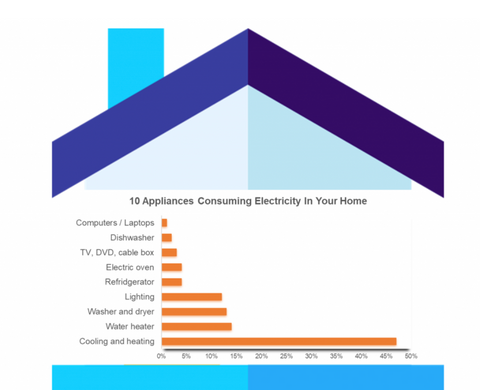A Simple Guide on Energy Usage Calculations
Do you get a sinking feeling every time the monthly electricity bill is about to arrive? If there only was a way to find out what the charge will be so that you could manage better. Well, there is! Today you will learn an easy way of calculating electricity bills, in just a couple of hours. Knowing your electric bill is the best way to take back control over your electricity costs and reduce how much energy you consume. Let’s forget all those times you scratched your head at your electricity cost.
Electricity Calculation Formula
Your electricity usage per month will have a direct correlation with your electricity billing. If you don’t like surprises, you can create an estimate for an electric bill, by simply adding up the energy usage of all appliances you use each month. After all, your electric bill is all your power consumption summed up in a single field.
To do this, you need to know the power consumption of each device you have. For this, you need to find the label on the backside. Markings saying something like ‘500W’ or “750W’ tell you how much electricity your appliance uses in an hour. This is the ‘appliance’s wattage’. Now, how can you calculate electricity consumption? If you know the wattage of your device, the formula here is pretty straight-forward:
Device Wattage (watts) x Hours Used Per Day = Watt-hours (Wh) per Day / 1000 = Kilowatt-hours (kWh) per Day
For example, If you watch your 125-watt television approximately 4 hours per day, you end up consuming 125 watts x 3 hours x 28 days = 10,500 Wh/Month / 1000 = 10,5 kWh/ Month.
This may not seem like much, but kWh usage really adds up and makes your monthly bills much higher.
Of course, using the kWh calculation for every single appliance in your house is very tedious so we will work with simple averages instead. Alternatively, you can purchase a simple device called an electricity usage monitor. This device plugs into your wall socket, and then you plug in the electronic device you want to monitor into it. Once you have a day’s worth of reading, it is easy to calculate the total cost of running this electronic device per month and year.

Use Household Averages
An easier and much more straightforward wait to calculate electricity costs is to look at the monthly energy consumption averages for an average household in the US. Although different households have different electricity bills every month, the average electricity usage per month is more or less the same for each state. This is especially true if you do the calculation of what your monthly use is per square foot.
o, houses in the south of the US, generally have the highest electricity usage for cooling, while the houses in the north have the highest monthly use in the winter – for heating. According to a recent study, a global partnership program launched by the World Bank Group, the breakdown in the energy use of a typical home looks something like this:
However, this chart is only indicative and does not reflect your actual usage. The actual kilowatt-hours you use that are on your energy bill will vary depending on your home size, your appliance’s wattage, and how much clean energy through your solar panels you get. If you want to find the average monthly usage in your home, you can do one of the following.
Use an APS Monitoring Device
This option will require some initial investment, even though it will probably save you more money down the road. A monitoring device is essentially an electricity meter, that connects to your electrical panel and tells you how much energy your home appliances are using. Some models even generate personalized recommendations to make your home more energy-efficient.
APS (Alabama Power Solutions) has two wonderful monitoring devices that work extremely well. With more than 3,000 in the field. APS (Alabama Power Solutions) residential monitoring devices are really affordable. (Alabama Power Solutions) residential monitoring device cost usually around $550. There are also less expensive monitors out there, but they don’t allow monitoring of how much electricity individual appliances use or their sensors aren’t as good. Always invest more money as knowing the monthly use of a typical appliance can save much electricity in the long run.
Calculate Power Bill Manually
This method is entirely free, even though it will definitely consume some of your time. That being said, it is empowering to understand your household’s energy consumption and you will likely gain a new appreciation for being eco-friendly and using less electricity. Depending on how much electricity you use every month and how much money you pay for each kilowatt-hour, you can save a significant amount of money.
All you need is a sheet of paper, where you list all the appliances in your house that consume electricity. Next, add two columns – Appliance Wattage and Monthly Usage in kilowatt-hours. There, the first step is done. You should also add a column with the hours an appliance is used every month, as this determines your total monthly use for that specific appliance.
How to Measure Electricity Usage by an Appliance
In order to determine the wattage for each appliance, you might have to do some detective work. The wattage of the product is often labeled on the back of the product itself. However, sometimes the label can also be at the bottom. It should look like this:
If the electricity label has been scratched over the years, or you can’t find it on the device, simply go on the Internet and look for the same or similar product to determine the number of watts it’s using. Usually, a simple search query is enough to give you all the details, for as long as you can tell the manufacturer and the model of the specific appliance.
Estimate Monthly Use and Calculate Kilowatt-Hours (kWh)
Once we determine the wattage of your appliances, we can proceed to calculate the kWh energy usage, or in layman’s terms – how much electricity these appliances use on a daily basis.
Go back to your sheet of paper and for each item, write down roughly how many hours you use the appliance on a monthly basis. For example, if you use your oven for 30 minutes to cook lunch and then another 30 minutes to cook dinner, that’s 1 hour/per day or 30 hours per month.
Then, multiply the appliance wattage by the hours used per month. If the wattage of your oven is 2500 watts, your calculation will be 2500 x 30 = 75,000 watts / 1000 = 75 kWh.
You would be surprised at the exact monthly use of each device. Repeat for each appliance on your list. Let’s look at some examples:
|
Appliance |
Wattage per Hour |
Hours of Use per Day |
kWh rate [$] |
Electricity Cost per Day |
Electricity Cost per Month |
Electricity Cost per Year |
|
Air Conditioner |
3,000 watt |
12 |
$0.1042 |
$3.75 |
$112.54 |
$1,369.19 |
|
Space Heater |
2,000 watt |
10 |
$0.1042 |
$2.08 |
$62.52 |
$760.66 |
|
Electric Water Heater |
2,000 watt |
5 |
$0.1042 |
$1.04 |
$31.26 |
$380.33 |
|
Oven |
2,700 watt |
1.5 |
$0.1042 |
$0.42 |
$12.66 |
$154.03 |
|
Hot Plate |
2,500 watt |
1 |
$0.1042 |
$0.26 |
$7.82 |
$95.08 |
|
Freezer |
300 watt |
3 |
$0.1042 |
$0.09 |
$2.81 |
$34.23 |
|
Fridge |
150 watt |
3.5 |
$0.1042 |
$0.05 |
$1.64 |
$19.97 |
|
Fan |
33 watt |
8 |
$0.1042 |
$0.03 |
$0.83 |
$10.04 |
|
LED Light |
7 watt |
6 |
$0.1042 |
$0.004 |
$0.13 |
$1.60 |
|
Laptop |
45 watt |
8 |
$0.1042 |
$0.04 |
$1.13 |
$13.69 |
*US average of $0.1142
Calculate the Cost of Electricity
At last, we are ready to estimate the electricity bill, based on our calculations. You will have to multiple your monthly power usage with the average electric rate per kWh to determine how high your next energy bill will be. It’s quite simple.
You live in Texas and you haven’t yet switched electric suppliers, which means that you are paying the standard electricity tariff of 11.85 cents per kWh or $0.1185 per kWh.
The average monthly energy consumption of an American household is between 500-2000 kWh. Find the total usage for all appliances you have calculated, add it up, and multiply it by your rate per kWh.
So, let’s say your calculated electricity usage per month came up to 1500 kWh – multiply it by 11.85 cents to get the estimated electricity bill of $177.5 (energy cost per month).
This will, of course, differ from one household to the next. One unit of the apartment does not use exactly the same amount of energy as another one.
Furthermore, the cost of electricity and how high your bill will depend on:
- The average number of people in your household,
- The cost of electricity in your area,
- How much power your typical appliance uses,
- How many hours a day the appliance runs,
- Whether you use gas or electricity for heating and cooling,
- If you are absent one month (for vacation) or not,
You should understand that when you measure your kWh usage and calculate the entire monthly usage, there will be mistakes you make. Measuring and calculating are here to give you an idea of the price you pay for each appliance, not to calculate the exact usage. This is what the meter system is here for.
Your electricity rate per kilowatt-hour will also have a significant impact on your final power bill. You might not be aware that average electricity rates differ in every state, from the cheapest Louisiana (7.71 cents / kWh) to the most expensive Hawaii at a whopping 37.18 cents / kWh.
If you are fortunate to live in one of the 18 energy-deregulated U.S. states, you can easily switch to an alternative power plan with a cheaper rate / kWh. Furthermore, adding a solar collector for water heating to your rooftop can help you save around 15-20% of your energy bill, and installing a solar panel array can reduce your energy use by 100% – plus you get the benefit of clean energy.

